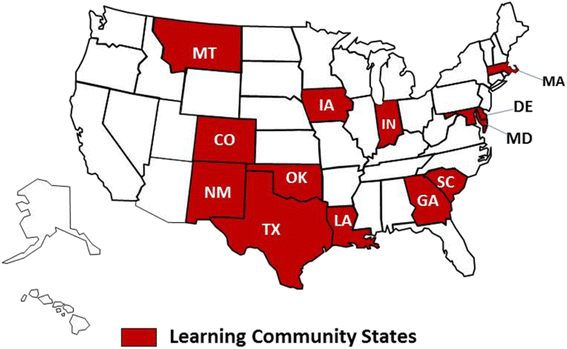Using a multi-state Learning Community as an implementation strategy for immediate postpartum long-acting reversible contraception
- PMID: 29162140
- PMCID: PMC5697070
- DOI: 10.1186/s13012-017-0674-9
Using a multi-state Learning Community as an implementation strategy for immediate postpartum long-acting reversible contraception
Abstract
Background: Implementation strategies are imperative for the successful adoption and sustainability of complex evidence-based public health practices. Creating a learning collaborative is one strategy that was part of a recently published compilation of implementation strategy terms and definitions. In partnership with the Centers for Disease Control and Prevention and other partner agencies, the Association of State and Territorial Health Officials recently convened a multi-state Learning Community to support cross-state collaboration and provide technical assistance for improving state capacity to increase access to long-acting reversible contraception (LARC) in the immediate postpartum period, an evidence-based practice with the potential for reducing unintended pregnancy and improving maternal and child health outcomes. During 2015-2016, the Learning Community included multi-disciplinary, multi-agency teams of state health officials, payers, clinicians, and health department staff from 13 states. This qualitative study was conducted to better understand the successes, challenges, and strategies that the 13 US states in the Learning Community used for increasing access to immediate postpartum LARC.
Methods: We conducted telephone interviews with each team in the Learning Community. Interviews were semi-structured and organized by the eight domains of the Learning Community. We coded transcribed interviews for facilitators, barriers, and implementation strategies, using a recent compilation of expert-defined implementation strategies as a foundation for coding the latter.
Results: Data analysis showed three ways that the activities of the Learning Community helped in policy implementation work: structure and accountability, validity, and preparing for potential challenges and opportunities. Further, the qualitative data demonstrated that the Learning Community integrated six other implementation strategies from the literature: organize clinician implementation team meetings, conduct educational meetings, facilitation, promote network weaving, provide ongoing consultation, and distribute educational materials.
Conclusions: Convening a multi-state learning collaborative is a promising approach for facilitating the implementation of new reimbursement policies for evidence-based practices complicated by systems challenges. By integrating several implementation strategies, the Learning Community serves as a meta-strategy for supporting implementation.
Keywords: Implementation science; Implementation strategies; Learning collaborative; Long-acting reversible contraception; Postpartum contraception.
Conflict of interest statement
Ethics approval and consent to participate
This project received an exemption from the Institutional Review Board at the University of Illinois at Chicago.
Consent for publication
Not applicable
Competing interests
The authors declare that they have no competing interests.
Publisher’s Note
Springer Nature remains neutral with regard to jurisdictional claims in published maps and institutional affiliations.
Figures
Similar articles
-
State-Identified Implementation Strategies to Increase Uptake of Immediate Postpartum Long-Acting Reversible Contraception Policies.J Womens Health (Larchmt). 2019 Mar;28(3):346-356. doi: 10.1089/jwh.2018.7083. Epub 2018 Nov 2. J Womens Health (Larchmt). 2019. PMID: 30388052 Free PMC article.
-
Application of Implementation Science Methodology to Immediate Postpartum Long-Acting Reversible Contraception Policy Roll-Out Across States.Matern Child Health J. 2016 Nov;20(Suppl 1):173-179. doi: 10.1007/s10995-016-2002-4. Matern Child Health J. 2016. PMID: 27085341 Free PMC article.
-
An initiative to implement immediate postpartum long-acting reversible contraception in rural New Mexico.Am J Obstet Gynecol. 2020 Apr;222(4S):S911.e1-S911.e7. doi: 10.1016/j.ajog.2020.01.027. Epub 2020 Jan 21. Am J Obstet Gynecol. 2020. PMID: 31978431
-
Immediate Postpartum Long-Acting Reversible Contraception: Review of Insertion and Device Reimbursement Policies.Womens Health Issues. 2021 Nov-Dec;31(6):523-531. doi: 10.1016/j.whi.2021.09.001. Epub 2021 Oct 1. Womens Health Issues. 2021. PMID: 34602326 Free PMC article. Review.
-
Using implementation mapping for the adoption and implementation of Target:BP in community health centers.Front Public Health. 2022 Nov 24;10:928148. doi: 10.3389/fpubh.2022.928148. eCollection 2022. Front Public Health. 2022. PMID: 36504969 Free PMC article. Review.
Cited by
-
The Spectrum of State Approaches to Medicaid Maternity Care Contracting.Milbank Q. 2024 Sep;102(3):692-712. doi: 10.1111/1468-0009.12707. Epub 2024 Jun 12. Milbank Q. 2024. PMID: 38865249
-
Increasing Access to Contraception in the United States: Assessing Achievement and Sustainability.J Womens Health (Larchmt). 2021 Sep;30(9):1217-1224. doi: 10.1089/jwh.2021.0414. J Womens Health (Larchmt). 2021. PMID: 34524017 Free PMC article.
-
Feasibility and acceptability of a toolkit-based process to implement patient-centered, immediate postpartum long-acting reversible contraception services.Am J Obstet Gynecol. 2022 Mar;226(3):394.e1-394.e16. doi: 10.1016/j.ajog.2021.10.009. Epub 2021 Oct 13. Am J Obstet Gynecol. 2022. PMID: 34655551 Free PMC article.
-
State-Identified Implementation Strategies to Increase Uptake of Immediate Postpartum Long-Acting Reversible Contraception Policies.J Womens Health (Larchmt). 2019 Mar;28(3):346-356. doi: 10.1089/jwh.2018.7083. Epub 2018 Nov 2. J Womens Health (Larchmt). 2019. PMID: 30388052 Free PMC article.
-
Implementing a Learning Collaborative Framework for States Working to Improve Outcomes for Vulnerable Populations: The Opioid Use Disorder, Maternal Outcomes, and Neonatal Abstinence Syndrome Initiative Learning Community.J Womens Health (Larchmt). 2020 Apr;29(4):475-486. doi: 10.1089/jwh.2020.8303. Epub 2020 Mar 13. J Womens Health (Larchmt). 2020. PMID: 32176568 Free PMC article.
References
-
- World Health Organization. Medical Eligibility Criteria for Contraceptive Use. Fifth ed. Geneva: World Health Organization; 2015.
MeSH terms
LinkOut - more resources
Full Text Sources
Other Literature Sources
Medical


